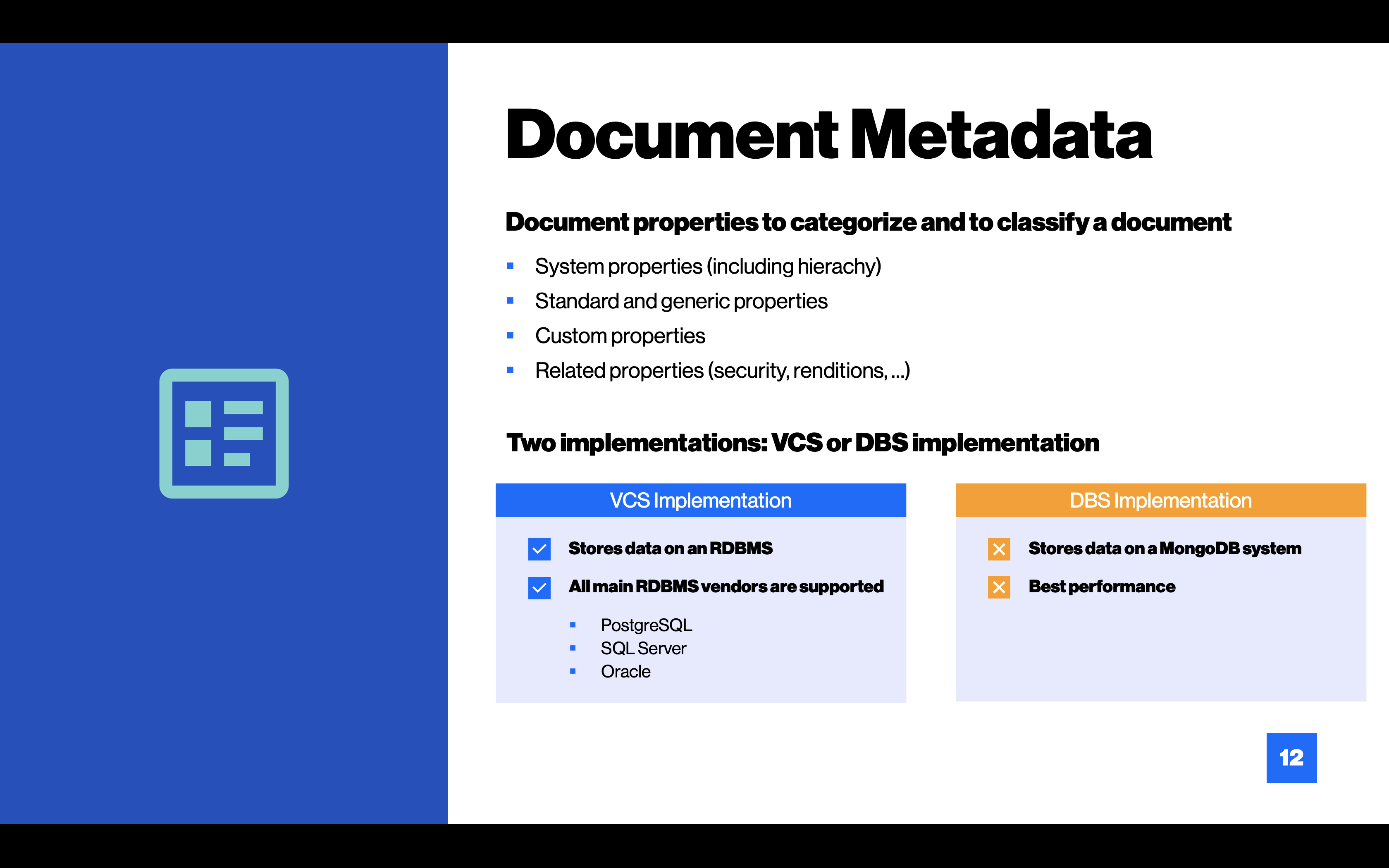Document-Based Storage (DBS) allows storage of Nuxeo documents inside a document-oriented store, like MongoDB or MarkLogic.


Basic Storage
When configured for use with MongoDB, each Nuxeo document is stored as a single MongoDB document. A sample document could look like:
{
"_id" : ObjectId("542e9bd23004722355960895"),
"ecm:id" : "612d0632-e12a-4374-88de-d6bd005bdcdc",
"ecm:parentId" : "399afabc-1eb5-4650-9049-b59d6da8d989",
"ecm:primaryType" : "Workspace",
"ecm:name" : "Records",
"ecm:lifeCyclePolicy" : "default",
"ecm:lifeCycleState" : "project",
"ecm:majorVersion" : NumberLong(0),
"ecm:minorVersion" : NumberLong(0),
"ecm:acp" : [
{
"name" : "local",
"acl" : [
{
"grant" : true,
"perm" : "Everything",
"user" : "Administrator"
},
{
"grant" : true,
"perm" : "Read",
"user" : "members"
}
]
}
],
"ecm:ancestorIds" : [
"00000000-0000-0000-0000-000000000000",
"1506bf11-4cb0-4ad4-94e3-ab0c1672c6c0",
"399afabc-1eb5-4650-9049-b59d6da8d989"
],
"ecm:racl" : [
"Administrator",
"members"
],
"ecm:fulltextSimple" : "img folder green png administrator administrator records administrator records",
"ecm:fulltextBinary" : "toto",
"icon" : "/img/folder_green.png",
"dc:title" : "Records",
"dc:description" : "",
"dc:created" : ISODate("2014-10-03T12:51:30.542Z"),
"dc:creator" : "Administrator",
"dc:modified" : ISODate("2014-10-03T12:51:30.542Z"),
"dc:lastContributor" : "Administrator",
"dc:contributors" : [
"Administrator"
],
"my:attachedFile" : {
"vignettes" : [
{
"content" : {
"length" : NumberLong(4),
"data" : "c30e7a7827dd9a8c9dd62af48e67c846",
"mime-type" : "plain/text",
"name" : "file.txt"
},
"height" : NumberLong(0),
"width" : NumberLong(0),
"label" : "vignettelabel"
}
],
"name" : "somename"
}
}
When configured for use with MarkLogic, each Nuxeo document is stored as a single MarkLogic document. A sample document could look like:
<document xmlns:xs="http://www.w3.org/2001/XMLSchema" xmlns:xsi="http://www.w3.org/2001/XMLSchema-instance">
<ecm__id xsi:type="xs:string">612d0632-e12a-4374-88de-d6bd005bdcdc</ecm__id>
<ecm__parentId xsi:type="xs:string">399afabc-1eb5-4650-9049-b59d6da8d989</ecm__parentId>
<ecm__primaryType xsi:type="xs:string">Workspace</ecm__primaryType>
<ecm__name xsi:type="xs:string">Workspace</ecm__name>
<ecm__lifeCyclePolicy xsi:type="xs:string">default</ecm__lifeCyclePolicy>
<ecm__lifeCycleState xsi:type="xs:string">project</ecm__lifeCycleState>
<ecm__majorVersion xsi:type="xs:long">0</ecm__majorVersion>
<ecm__minorVersion xsi:type="xs:long">0</ecm__minorVersion>
<ecm__acp>
<ecm__acp__item>
<name xsi:type="xs:string">local</name>
<acl>
<acl__item>
<grant xsi:type="xs:boolean">true</grant>
<perm xsi:type="xs:string">Everything</perm>
<user xsi:type="xs:string">Administrator</user>
</acl__item>
<acl__item>
<grant xsi:type="xs:boolean">true</grant>
<perm xsi:type="xs:string">Read</perm>
<user xsi:type="xs:string">members</user>
</acl__item>
</acl>
</ecm__acp__item>
</ecm__acp>
<ecm__ancestorIds>
<ecm__ancestorIds__item xsi:type="xs:string">00000000-0000-0000-0000-000000000000</ecm__ancestorIds__item>
<ecm__ancestorIds__item xsi:type="xs:string">1506bf11-4cb0-4ad4-94e3-ab0c1672c6c0</ecm__ancestorIds__item>
<ecm__ancestorIds__item xsi:type="xs:string">399afabc-1eb5-4650-9049-b59d6da8d989</ecm__ancestorIds__item>
</ecm__ancestorIds>
<ecm__racl>
<ecm__racl__item xsi:type="xs:string">Administrator</ecm__racl__item>
<ecm__racl__item xsi:type="xs:string">members</ecm__racl__item>
</ecm__racl>
<ecm__fulltextSimple xsi:type="xs:string">img folder green png administrator administrator records administrator records</ecm__fulltextSimple>
<ecm__fulltextBinary xsi:type="xs:string">toto</ecm__fulltextBinary>
<icon xsi:type="xs:string">/img/folder_green.png</icon>
<dc__title xsi:type="xs:string">Records</dc__title>
<dc__description xsi:type="xs:string"></dc__description>
<dc__created xsi:type="xs:dateTime">2014-10-03T12:51:30.542</dc__created>
<dc__creator xsi:type="xs:string">Administrator</dc__creator>
<dc__modified xsi:type="xs:dateTime">2014-10-03T12:51:30.542</dc__modified>
<dc__lastContributor xsi:type="xs:string">Administrator</dc__lastContributor>
<dc:contributors>
<dc__contributors__item xsi:type="xs:string">Administrator</dc__contributors__item>
</dc:contributors>
<my__attachedFile>
<vignettes>
<vignettes__item>
<content>
<length xsi:type="xs:long">4</length>
<data xsi:type="xs:string">c30e7a7827dd9a8c9dd62af48e67c846</data>
<mime-type xsi:type="xs:string">plain/text</mime-type>
<name xsi:type="xs:string">file.txt</name>
</content>
<height xsi:type="xs:long">0</height>
<width xsi:type="xs:long">0</width>
<label xsi:type="xs:string">vignettelabel</label>
</vignettes__item>
</vignettes>
<name xsi:type="xs:string">somename</name>
</my__attachedFile>
</document>
Schema Properties
For user-defined schemas (and regular Nuxeo schemas, like dublincore), properties are stored as you would expect in JSON (or XML for MarkLogic):
- Regular properties directly (like
dc:titleordc__title). - List properties as lists (like
dc:contributorsordc__contributors). - Complex properties as JSON/XML sub-document (like
my:attachedFileordc__contributors). - Lists of complex properties as lists of JSON/XML sub-documents (like
my:attachedFile.vignettesormy__attachedFile/my__attachedFile__item/vignettes). - Binaries as a JSON sub-document containing a digest value or a Blob Provider key (like
content.dataorcontent/data) and other metadata (content.mime-type, etc.).
System Properties
A number of expected system properties are also present: ecm:id, ecm:parentId, ecm:name, ecm:pos, ecm:primaryType, ecm:majorVersion, etc. You'll find a full list as constants in the DBSDocument class.
The ecm:acp complex property represents the ACP defined on the document.
There are also some fulltext-related properties: ecm:fulltextSimple and ecm:fulltextBinary, which are tied to a MongoDB text index.
Search-Related Properties
A few system properties are computed from others in order to get efficient subtree searches and efficient security checks. They are:
ecm:ancestorIds: the list of ancestors for the documentecm:racl: the list of identities having read access to the document
Proxies
Proxies cannot be queried and retrieved with a JOIN, contrary to Visible Content Story (VCS), so they are stored as copies of the documents they point to, and are updated every time their target changes. In order to do this, some properties are maintained on proxies and proxy targets:
ecm:proxyTargetId: the target of the proxyecm:proxyIds: the proxies that target this document
Storage Restrictions
Due to the nature of the MongoDB storage, we use a transaction model equivalent to Read Uncommitted, which means that a transaction may read data written but not yet committed by another transaction. This is unavoidable in most Document-Based stores, and should be taken into account by applications.
As MarkLogic relies on Document Based Storage (DBS), we are currently using the same transactional behavior.
Full-text configuration is fixed to a default useful for evaluation (all textual fields and blobs are indexed), but a production instance should use Elasticsearch with a suitable full-text configuration.